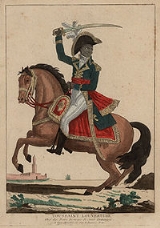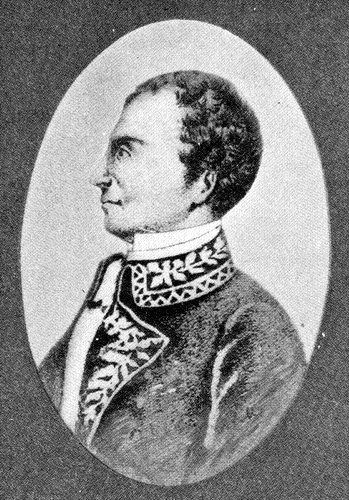
War of Knives
Encyclopedia


Toussaint L'Ouverture
François-Dominique Toussaint Louverture , also Toussaint Bréda, Toussaint-Louverture was the leader of the Haitian Revolution. His military genius and political acumen led to the establishment of the independent black state of Haiti, transforming an entire society of slaves into a free,...
, a Black, and his adversary André Rigaud
André Rigaud
Benoit Joseph André Rigaud was the leading mulatto military leader during the Haïtian Revolution. Among his protégés were Alexandre Pétion and Jean-Pierre Boyer, both future presidents of Haïti.-The revolutionary:...
, a mulatto
Mulatto
Mulatto denotes a person with one white parent and one black parent, or more broadly, a person of mixed black and white ancestry. Contemporary usage of the term varies greatly, and the broader sense of the term makes its application rather subjective, as not all people of mixed white and black...
, from June 1799 to March 1800. These men fought over control of Haiti after defeating foreign forces. Rigaud
André Rigaud
Benoit Joseph André Rigaud was the leading mulatto military leader during the Haïtian Revolution. Among his protégés were Alexandre Pétion and Jean-Pierre Boyer, both future presidents of Haïti.-The revolutionary:...
won a significant victory over the British invasion, and Toussaint was of a superior rank in the French Army. This left both individuals with a right to claim leadership, however priority was given to Toussaint by the majority. Rigaud
André Rigaud
Benoit Joseph André Rigaud was the leading mulatto military leader during the Haïtian Revolution. Among his protégés were Alexandre Pétion and Jean-Pierre Boyer, both future presidents of Haïti.-The revolutionary:...
refused to recognize the appointment so an armed conflict began.
Location
The conflict took place mainly in JacmelJacmel
Jacmel, also known by its indigenous Taíno name of Yaquimel, is a town in southern Haiti founded in 1698. It is the capital of the department of Sud-Est and has an estimated population of 40,000, while the municipality of Jacmel had a population of 137,966 at the 2003 Census.The buildings are...
where the rebels, led by Rigaud, were forced to make their final stand. Jacmel
Jacmel
Jacmel, also known by its indigenous Taíno name of Yaquimel, is a town in southern Haiti founded in 1698. It is the capital of the department of Sud-Est and has an estimated population of 40,000, while the municipality of Jacmel had a population of 137,966 at the 2003 Census.The buildings are...
fell to Toussaint in March 1800. Rigaud was exiled to France
France
The French Republic , The French Republic , The French Republic , (commonly known as France , is a unitary semi-presidential republic in Western Europe with several overseas territories and islands located on other continents and in the Indian, Pacific, and Atlantic oceans. Metropolitan France...
shortly after, only to return three years later.

